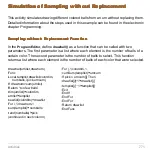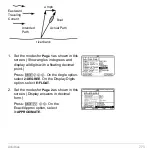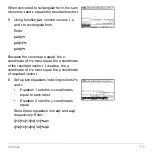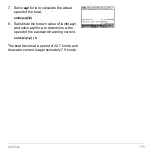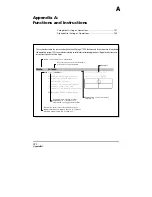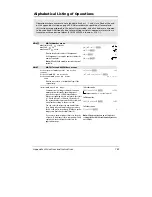
Appendix A: Functions and Instructions
785
abs()
MATH/Number menu
abs(
expression1
)
⇒
⇒
⇒
⇒
expression
abs(
list1
)
⇒
⇒
⇒
⇒
list
abs(
matrix1
)
⇒
⇒
⇒
⇒
matrix
Returns the absolute value of the argument.
If the argument is a complex number, returns the
number’s modulus.
Note:
All undefined variables are treated as real
variables.
abs({
p
/2,
ë
p
/3})
¸
{
p
2
p
3
}
abs(2
ì
3
i
)
¸
13
abs(z)
¸
|z|
abs(x+y
i
)
¸
x
2
+y
2
and
MATH/Test and MATH/Base menus
Boolean expression1
and
expression2
⇒
⇒
⇒
⇒
Boolean
expression
Boolean list1
and
list2
⇒
⇒
⇒
⇒
Boolean list
Boolean matrix1
and
matrix2
⇒
⇒
⇒
⇒
Boolean
matrix
Returns true or false or a simplified form of the
original entry.
x
‚
3 and x
‚
4
¸
x
‚
4
{x
‚
3,x
0} and {x
‚
4,x
ë
2}
¸
{x
‚
4 x
ë
2}
integer1
and
integer2
⇒
⇒
⇒
⇒
integer
Compares two real integers bit-by-bit using an
and
operation. Internally, both integers are
converted to signed, 32-bit binary numbers.
When corresponding bits are compared, the result
is 1 if both bits are 1; otherwise, the result is 0.
The returned value represents the bit results, and
is displayed according to the
Base
mode.
You can enter the integers in any number base.
For a binary or hexadecimal entry, you must use
the 0b or 0h prefix, respectively. Without a prefix,
integers are treated as decimal (base 10).
If you enter a decimal integer that is too large for
a signed, 32-bit binary form, a symmetric modulo
operation is used to bring the value into the
appropriate range.
In Hex base mode:
0h7AC36 and 0h3D5F
¸
0h2C16
In Bin base mode:
0b100101 and 0b100
¸
0b100
In Dec base mode:
37 and 0b100
¸
4
Note:
A binary entry can have up to 32 digits (not
counting the 0b prefix). A hexadecimal entry can have
up to 8 digits.
Alphabetical Listing of Operations
Operations whose names are not alphabetic (such as +, !, and >) are listed at the end
of this appendix, starting on page 900. Unless otherwise specified, all examples in
this section were performed in the default reset mode, and all variables are assumed
to be undefined. Additionally, due to formatting restraints, approximate results are
truncated at three decimal places (3.14159265359 is shown as 3.141...).
Important:
Zero, not the letter O.
Summary of Contents for Voyage 200
Page 36: ...Getting Started 36 D B D B Press Result ...
Page 45: ...Getting Started 45 3 0 D B D D B D Press Result ...
Page 46: ...Getting Started 46 D 2 0 0 2 D B Scroll down to October and press Press Result ...
Page 60: ...Getting Started 60 B D Press Result ...
Page 139: ...Previews 139 8 Complete the operation Press 2 d Steps and keystrokes Display 5 f 2 ...
Page 453: ...Differential Equation Graphing 453 ...
Page 468: ...Tables 468 ...
Page 777: ...Activities 777 ...



